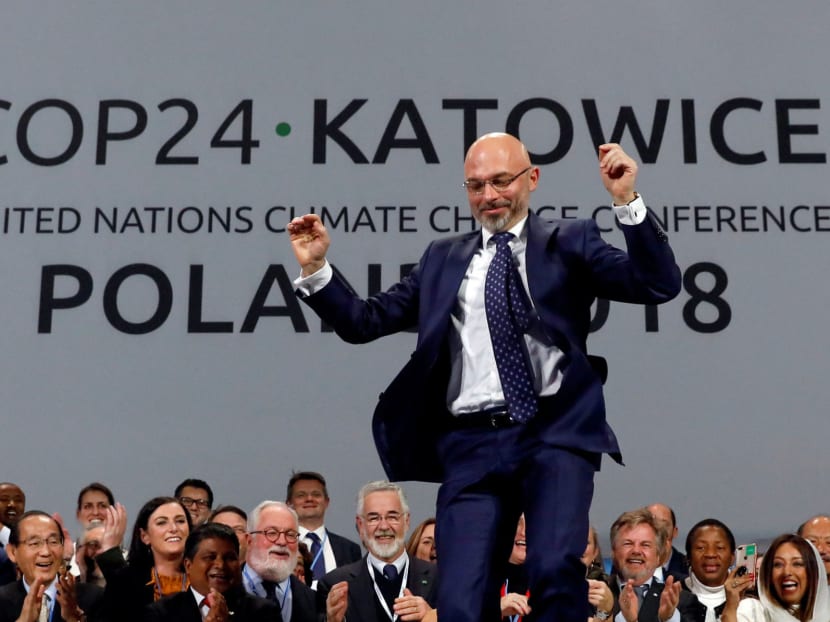Climate summit jamborees could use a good clean-up
In the world of climate change, one summit rules them all: the COP. The annual United Nations meeting, or “Conference of the Parties” to the Convention on Climate Change, is unlike any other.

COP24 President Michal Kurtyka reacts during a final session of the COP24 United Nations Climate Change Conference 2018 in Katowice, Poland on Dec 15, 2018.
In the world of climate change, one summit rules them all: the COP. The annual United Nations meeting, or “Conference of the Parties” to the Convention on Climate Change, is unlike any other.
An alien looking down from space on a COP might puzzle at the sight of 20,000 humans swarming across a giant conference centre, some crammed into negotiation rooms, others giving speeches in cavernous halls, others staging protests and a handful even singing and dancing.
The modern COP has evolved into a big jamboree, a combination of stodgy UN formality alongside a certain zaniness (think of activists in costumes, vegan sushi, drum circles and elaborate protest stunts).
But what is a COP really about? What is its purpose? Presumably, it is a global summit to avoid catastrophic climate change by reducing emissions of greenhouse gases as quickly as possible.
But the nature of the COP summits has changed a lot since they began in 1995.
The meetings have swollen in size — from about 4,000 delegates at the first COP in Berlin to a peak of nearly 30,000 in Paris in 2015.
What began as a small technical negotiation has acquired activism and political theatre.
With the United Kingdom hosting the 26th COP this autumn — already delayed a year by the pandemic — it is an opportune moment to consider if the world still needs this mega-COP format.
As Covid-19 continues, it will be difficult if not impossible to hold a normal COP, no matter what safeguards the organisers put in place. (See how preparations for the Tokyo Olympics are going.)
The British hosts of COP26 plan to hold it in Glasgow in November, at a scale that is as close to normal as virus safety protocols will allow.
Even before the pandemic, a conversation was under way at the UN about the size of the COP.
“Sometimes we all need to take a good look in the mirror. And I think (this) process will have to do that as well,” Marianne Karlsen, chair of a UN group, the Subsidiary Body for Implementation, that oversees the implementation of the Paris climate accord, said in March.
Ms Karlsen, a Norwegian climate negotiator, pointed to negotiations which went on past their allotted time, and to the rapid growth in attendance over the years.
“We need to ask ourselves a key question — can we do more with less?”
A recent report concludes a much smaller COP, focused on technical negotiations, might be almost as effective.
The downsides of the current system include the expense (which can run to more than US$100 million for host countries) as well as the emissions of so many people flying in to attend.
The report, funded in part by the German government and produced by Oxford Climate Policy, recommends separating out the formal COP negotiations from the “jamboree” of climate action, which can take place at different times and places.
Lead author Benito Müller, of Oxford Climate Policy, says that stripping COP back to basics would let negotiators to do their jobs better.
“I really did think, to what extent do we need this travelling circus?” he said.
“The circus has grown fairly anarchically. Whenever there was a new thing, we added it on to negotiation sessions.”
A change makes sense because, with the Paris climate accord already in place, future COP summits will exist mainly to monitor the agreement.
Supporters of the current format argue that creating political momentum and support for climate pledges is an essential part of the COP.
But unlike in previous years, the upcoming COPs won’t be tasked with negotiating a global treaty, which required much political involvement.
This shift is already visible.
Over the past year the world’s biggest emitters, such as the United States, China and the European Union, have made big pledges as they work to meet their Paris accord obligations, though no COP has been held in this period.
Several climate summits have produced fresh environmental commitments from countries and companies.
This all poses a challenge for the summit in Glasgow in November, because most headline pledges will come out long before COP26 even begins.
But this could also make it easier to experiment with different formats, particularly if Covid-19 makes the full jamboree impossible.
Even a smaller COP would still be important, not least because the format allows every country, no matter how small, to be heard on an equal footing.
But just as Covid-19 has forced a reckoning for many aspects of modern life, it is time for that same re-evaluation to take place for the COP.
As long as the rest of the world can keep up the beating drum of climate action, perhaps the beating drums don’t need to be inside the negotiation venue itself. FINANCIAL TIMES
ABOUT THE AUTHOR:
Leslie Hook is an environment and clean energy correspondent at the Financial Times.






